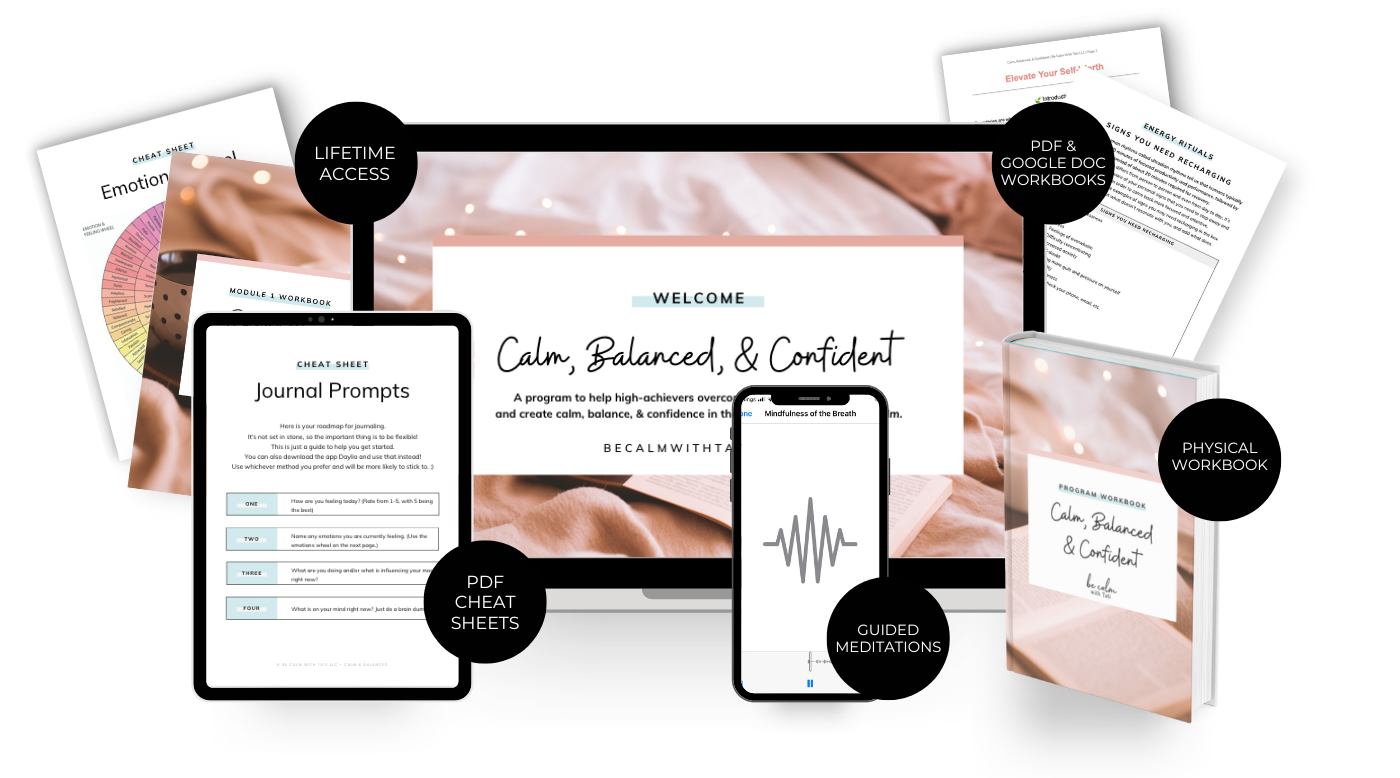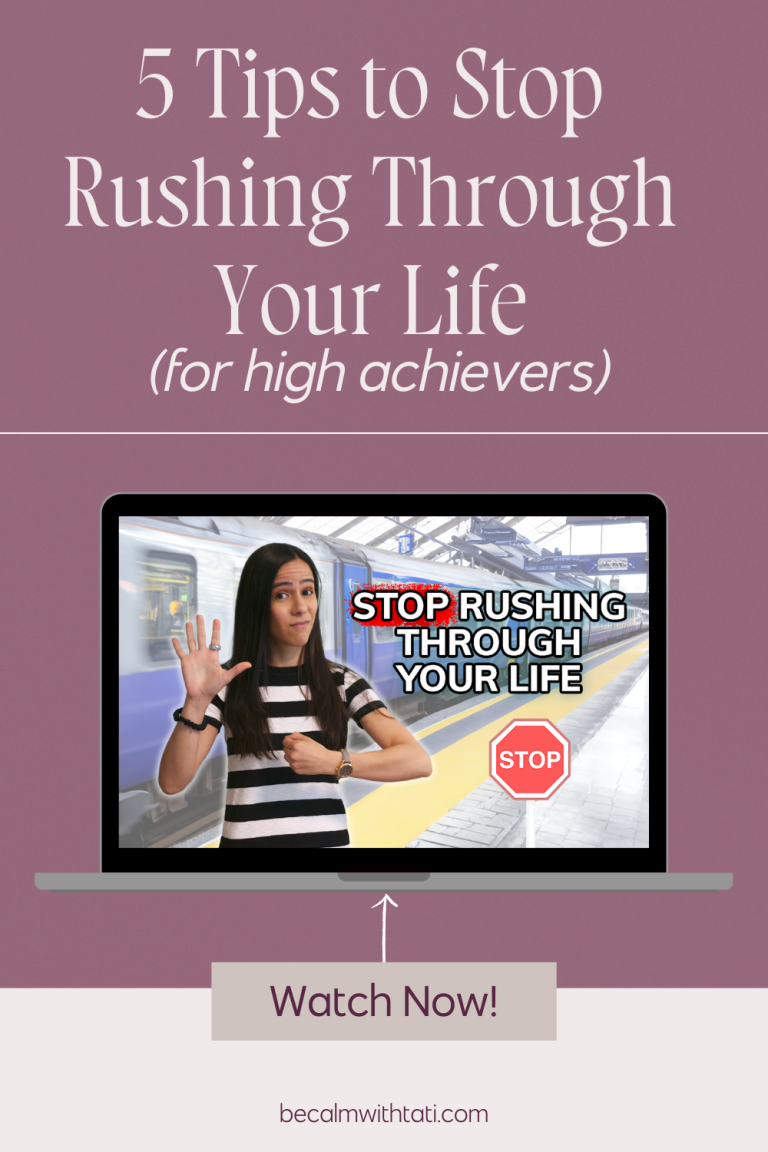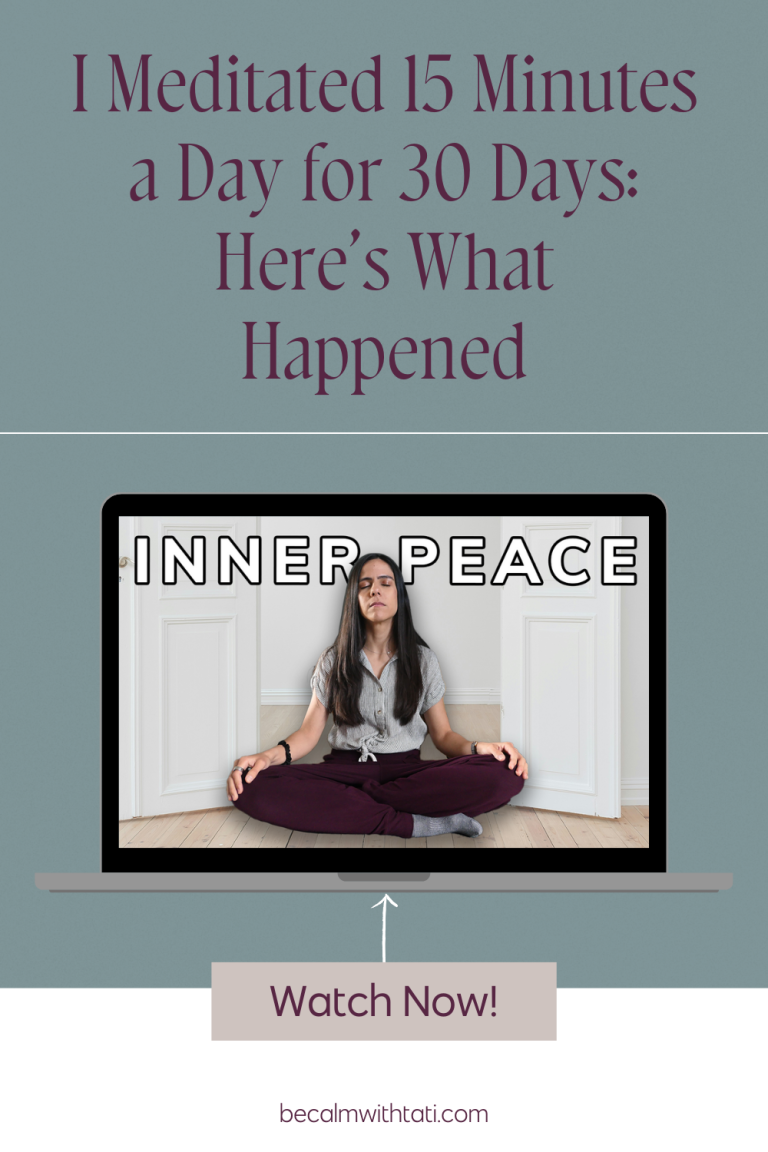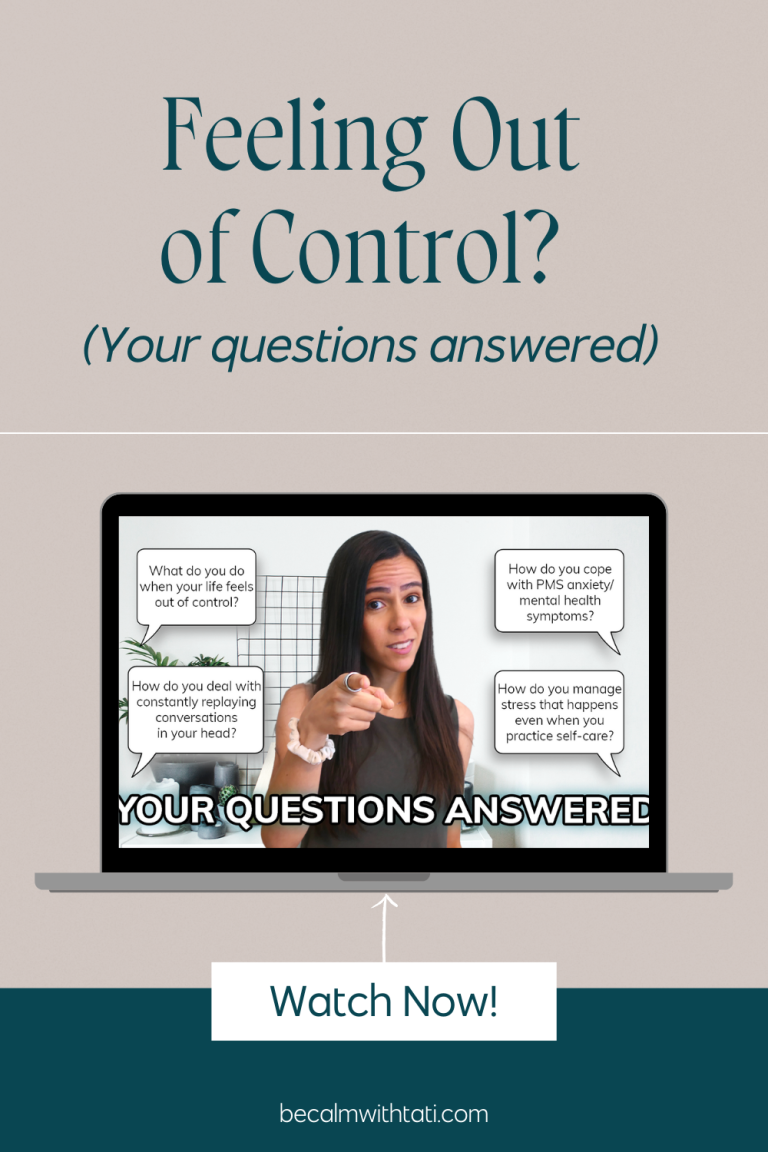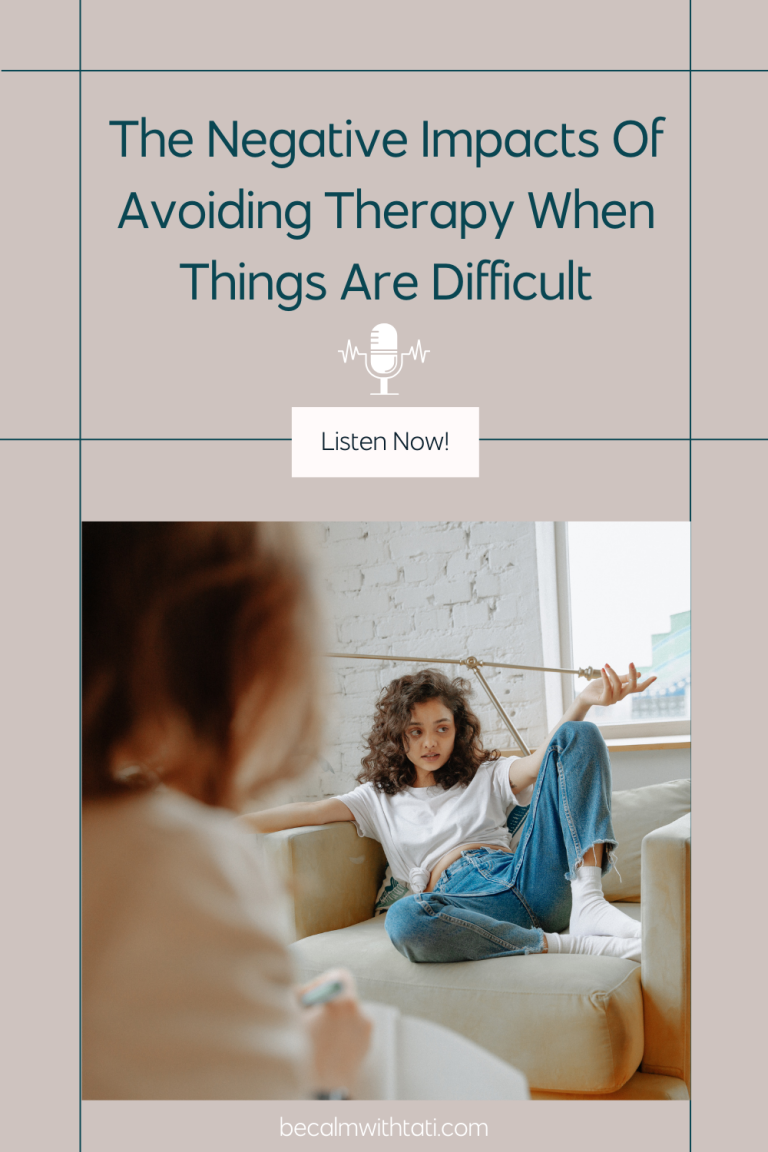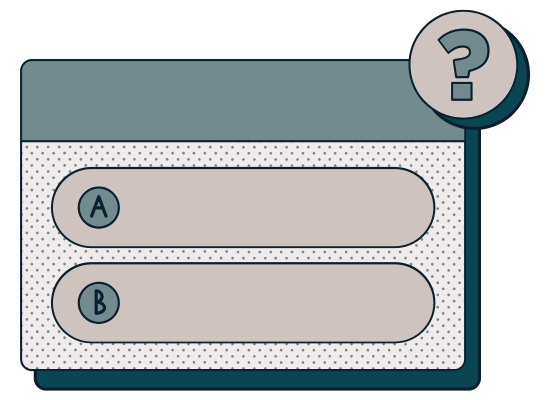Do you spend more time in your head thinking that you do feeling fully present in your life? Thinking about the future, planning for what’s to come, overthinking what you said during that meeting yesterday, and on and on and on… Thinking is powerful: it helps us reflect, process, and solve problems. But when you have trouble getting OUT of your head and into the present it can feel oppressive. In this episode, I’ll explore how you can get out of your head so you can start being fully present in your life.
In this episode, you will learn:
- 7 actionable tips to help you get out of your head
- Mindset shifts you need to know to change your relationship with your thoughts
- The counterintuitive tip that will help you stop overthinking
LISTEN NOW:
🎧 CLICK HERE TO LISTEN TO CALMLY COPING WHEREVER YOU LISTEN TO PODCASTS
WATCH NOW:
Mentioned in episode:
Cultivating Self-Trust: Anxiety vs Intuition: https://www.becalmwithtati.com/anxiety-vs-intuition/
🎓 Learn more about The Calm & Ambitious Membership: Calm and Ambitious
💬 Submit a message, question, or suggestion to the podcast: Message
FREE TRAINING: Achieve A Calm Mind, Balanced Life, & Empowered Confidence in 90 Days
If you want to learn how to take back control of your life so you can feel calmer and more confident, and learn the tools to spend your time according to what matters most to you (no matter what your schedule is like right now)…
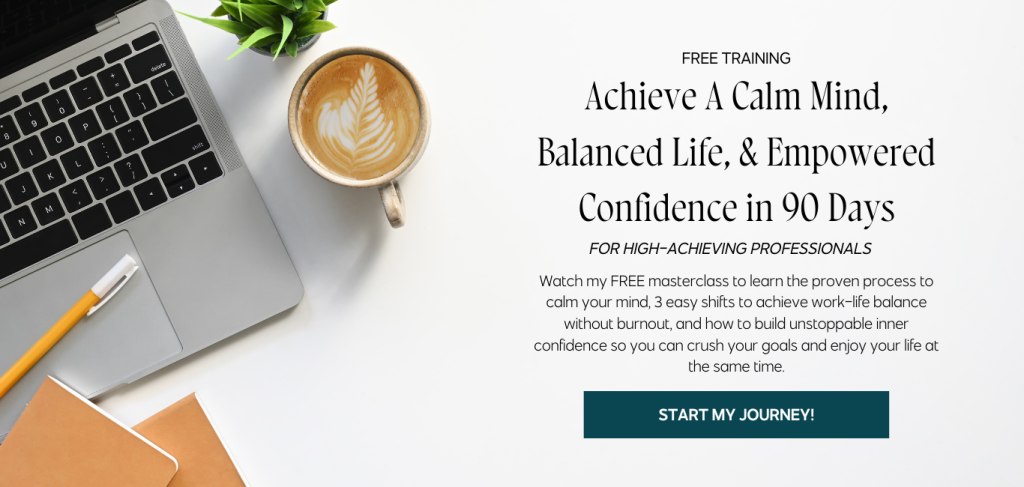
LISTEN, REVIEW, AND SUBSCRIBE TO THE PODCAST!
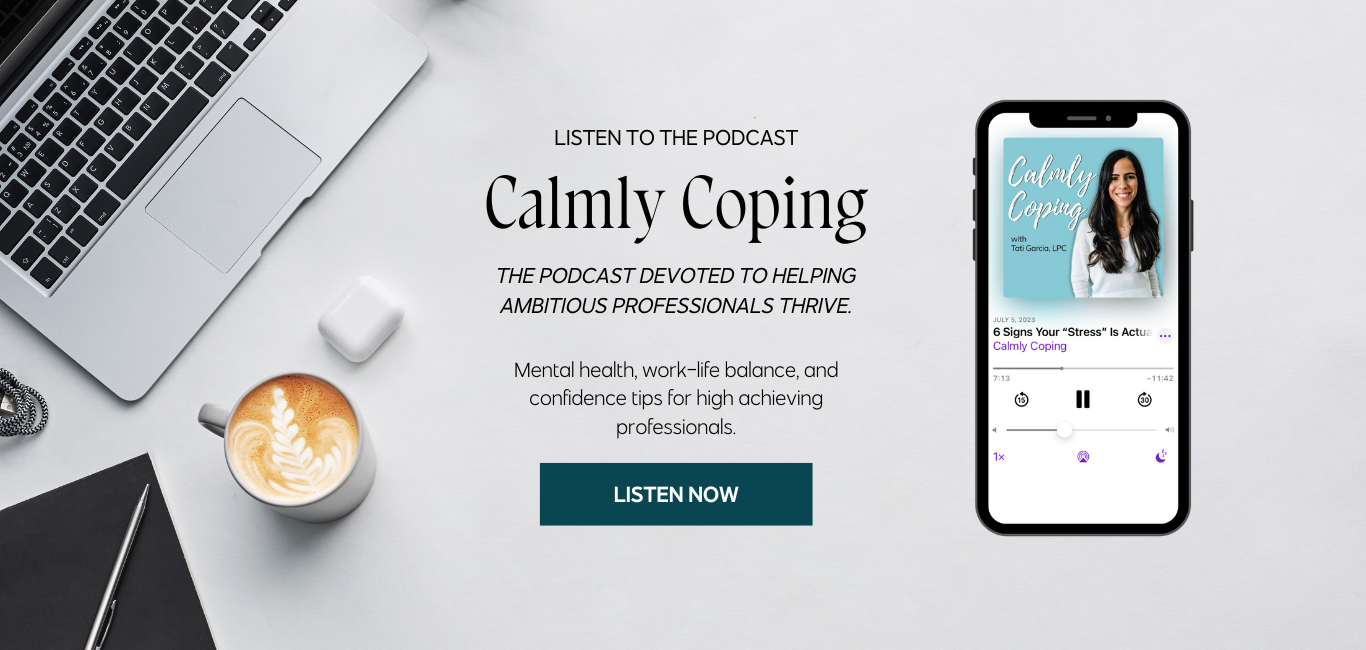
INTRO/OUTRO MUSIC: Rescue Me (Instrumental) by Aussens@iter (c) copyright 2018 Licensed under a Creative Commons Attribution (3.0) license. http://dig.ccmixter.org/files/tobias_weber/57990 Ft: Copperhead
DISCLAIMER: All content here is for informational purposes only. This content does not replace the professional judgment of your own mental health provider. Please consult a licensed mental health professional for all individual questions and issues.
Interested in diving deeper to get support for high-functioning anxiety?
I offer 1:1 coaching to help high-achievers overcoming high-functioning anxiety so they can feel calmer, more present, and have improved balance in their lives. Click here if you’re interested in learning more and getting started.
Calm, Balanced, & Confident is my comprehensive A→Z self-paced course to help high-achieving professionals overcome high-functioning anxiety so they can feel calmer, balanced, and more confident without the anxiety and overwhelm. Click here to learn more and enroll today.
Looking for ongoing support and guidance with high-functioning anxiety? The Calm & Ambitious Community is the exclusive community for high achievers with high-functioning anxiety. Click here to learn more and join us today!
TRANSCRIPT:
Click to view the episode transcript.
Do you spend more time in your head thinking than you do feeling fully present in your life? Thinking about the future, planning for what’s to come, thinking about what you said in that conversation yesterday, and on and on and on. Thinking is powerful. It helps us reflect and solve problems. But when you have trouble getting out of your head and into the present, it can feel oppressive.
In this episode, I’ll explore how you can get out of your head so you can start to feel fully present in your life. Welcome to Calmly Coping. I’m your host Tati Garcia. I’m a licensed therapist and a high functioning anxiety coach. Calmly Coping is the podcast for people who struggle with anxiety and high functioning anxiety.
Each Wednesday, you’ll hear informative episodes with actionable tips about decreasing anxiety, adopting a healthy mindset, and managing your time and energy so you can live a calm and balanced life. Let’s get started. Thank you so much for tuning in. Full disclosure, I am not always in the mood to record and today was one of those days where it’s kind of like a slog to get here even though I really enjoy talking about these things.
We all have our ups and downs as humans and today is just one of those days for me where I’m like feeling like not in the mood to be in front of a camera. However, I know that it’s something that is important for me to just continue with the consistency and stay with my schedule. And so what I did was I modified my plan.
And so rather than being stuck coming with the topic of this episode, staying stuck in my head over thinking, I really don’t want to do this. I should be doing this. And I’m just going to force myself to do it. Even though I really don’t want to, I already had a plan. I was like, I was feeling inspired to talk about this topic specifically, so I threw together a quick outline for this episode, and I’m going to, I’m recording this episode today, and I’m going to shift the other few episodes that I was going to record, because I usually batch my episodes, to another day for when I can come in feeling fully ready and prepared, and so going on that topic of getting out of your head, sometimes Taking action is a helpful way to get out of your head and into your life.
We can spend so much time being hard on ourselves, putting shoulds on ourselves, and expectations, and all of these other things that we feel like, you know, we have this plan for how things should be. should quote unquote be going or you know worrying about all of the possible negative consequences or whatever it is that happens when you’re stuck in your head thinking about things but that is never going to actually get you out of thinking about those things.
In fact the more that you stay stuck there the more you add fuel to the fire and the more you get stuck in what we call this downward spiral often because a lot of times our thoughts go our focus on the negative of just continuing to feel worse and worse and worse. So in order to get out of your head, a really effective way can be taking action.
And it’s not just doing anything, but taking effective action. Thinking, what can I do in this moment that will help me to address this thing that I am feeling? can’t get out of my head about. So if it’s a decision that you’re making, maybe that is taking the first step, or if it’s something that you’re procrastinating, or if it’s something that you know that you quote unquote should be doing, but you don’t want to do or whatever, kind of exploring and seeing, okay, what can I do to take action on this?
Maybe it’s not in exactly the way that I anticipate, or maybe there’s possible negative consequences. And you know, the reality is in order to make progress on things, we need to take risks. So for many things, there can be negative consequences, but I’m sure that you’ve taken action in the past and done things that have resulted in potential negative consequences or bad things could have happened and you’ve survived.
And you’ve overcome it. And so you can continue to do it again and again. And that’s actually what helps you to grow stronger and helps you to practice the action of getting out of your head in this place of stagnation and overthinking and overanalyzing and into a place of feeling more of a sense of control and not allowing fear to hold you back from what it is that is important to you and what you value.
My next tip is to have experiences outside of the norm. We can all get stuck in the mundanity of day to day, of going through our routines and responsibilities, and checking things off of the list, and that is great, and that is a normal part of being human. However, sometimes we can get stuck in these routines and then get into autopilot, and that can keep us more and more in our heads.
So if we can have experiences outside of the routine. So maybe that is, you know, stepping away from work and responsibilities, having fun, even if it’s something small, even if it’s just something that will help you to add a little bit of excitement or pleasure into your day, seeing if you can practice doing those things, taking time for yourself or with loved ones, or to do things that maybe you might normally say, I don’t have time for this.
thing or I really need to check this thing off and the reason I suggest this for getting out of your head and into your life is because oftentimes the things that allow us to feel fully present are the activities that we enjoy, whether that is spending time with friends and family or doing a hobby that you really enjoy or going for a walk or being in nature or exercising, think about for you, cause this is going to be different for each and every person, but what are the things that allow you to feel fully present?
Maybe you can feel fully present in your day to day activities. And if you have trouble with that, even, and this is going to touch on a later tip that I share, but practicing being present in those moments for the things you do, but sometimes a simpler way to start is to practice doing something that is.
novel or fun or that you enjoy and oftentimes those are the activities where you can feel more fully present. So maybe making a list of things and thinking back on when are the times in my life where I’ve felt like I can be present, where I haven’t been stuck in my head overthinking things. Another important tip for getting out of your head and into your life is your relationship with your thoughts.
It is so important to see your thoughts as just that. Thoughts And nothing more. Because oftentimes, we can start to believe our thoughts. We can attach meaning to our thoughts. We can see them as facts. And oftentimes, they aren’t. And that then affects the way that we feel, right? So if you’re having thoughts like, I’m never going to be happy, or I am super overwhelmed, and I’m never going to be able to relax.
or whatever other kinds of thoughts you might be having, those thoughts are then going to affect the way you feel and make you feel hopeless and make you feel discouraged. So it’s important to have a separation from your thoughts so that they are not really kind of running the show when it comes to how you’re feeling.
So seeing that your thoughts are are just thoughts. We all have thoughts that come up that are thoughts that we don’t want to have. Thoughts that we’re like, why am I thinking about that? Thoughts that we don’t believe. If you’re somebody who struggles with anxiety, especially OCD, obsessive compulsive disorder, maybe you have intrusive thoughts and intrusive thoughts are these really distressing, disturbing thoughts that come in and just like how it sounds, they are intrusive.
They are beyond our control. And that can be disturbing, you know, that can be disconcerting. And it’s important to recognize that thoughts are just thoughts. They do not define who you are as a person. They do not define your values or your views or anything like that. And when we can have that thought, separation and recognize that, okay, my brain’s just doing what it does, which is think, and that’s what all of our brains do.
Some of our brains think more, some of our brains think in different ways. There’s nothing right or wrong about that. But when you can identify that, acknowledge that and see, okay, I’m having a thought that happens. Okay. is something that’s really negative and it’s really having a negative effect on me.
How can I label this as, this is a thought, this is not a fact. Maybe I can look at the evidence in this situation and see what is actually true versus what is my opinion and what is coming from a place of fear or sadness or whatever other emotions could be. influencing your thinking. And one way that I like to think of describing your thoughts is kind of watching them flow by like leaves in a stream.
This is something if you’ve ever done meditation you might have heard. You could imagine like your thoughts are flowing by in your head like you’re watching leaves flowing by in a stream or like you’re watching clouds floating by in the sky. Your thoughts are just going to flow by and You don’t have to attach to them.
You don’t have to latch onto them and then feed into them, but you can notice them and then allow them to just continue on without believing what they are telling you. This is a super powerful tip when it comes to getting out of your head, because that gives you the control to step away and say, well, I don’t need to be kind of embroiled in these.
thoughts. I don’t need to be trapped in my head thinking about all of these things, but I can choose to let go and be present. I can choose to let go and focus on something different. My next step is to start listening to your body. That’s because being in tune with your body is going to naturally get you out of your head and out of thinking.
So this can include things like your physical sensations. Do you notice tension anywhere in your body? Do you notice tightness? Do you notice any lightness or comfort in your body? Just noticing what is here. Are you experiencing hunger cues? Are you experiencing any sort of urge or pull for something or to do something?
Sometimes, and I know this happens to me a lot, I can be sitting somewhere and my head is already kind of over in the kitchen making my lunch rather than being right here. You know, are you noticing that your mind is wanting your body to be somewhere else and there’s these urges to do this or to kind of like project into the future?
And can you bring it back to what is here right now in your body and just notice? those urges or those preferences, because our bodies communicate to us, right? The way that we exist is not just in our brains. It’s not just in thinking, but it’s through our entire body. And through life, we often become more disconnected from our bodies.
We often learn to prioritize thinking and proceeding in that way, especially if you are a person who something like intelligence. and achievement has been prioritized and has been rewarded throughout your life, and you’re somebody who maybe tends to be more cerebral, then that is gonna be even more pronounced, where you’re gonna have this conditioning that’s making it so that you’re more likely to live in your head and prioritize that, rather than connecting with your body.
So anything that allows you to tune into your body, so that can be things like yoga or exercise, just going for it. what’s considered a mindful walk. So this is just going for a walk anywhere. It doesn’t have to be anywhere fancy or super, you know, in nature or anything like that. It could be in your house, on your street, in your community, wherever.
And you’re just tuning into what you notice in your body. This is one small way to get out of your head, right? Literally by getting into your body. Something else that can be helpful or things like, breath work or taking deep breaths, any practice where you are tuning into your physical experience and building this muscle will not just help you to be present in your body and help to slow down the torrent of of overthinking and being stuck in your head, but it will also help you to build the skill of listening to yourself.
I did a previous episode on the difference between anxiety and intuition and how to connect to your desires, how to connect with your mind. the preferences that you have for certain things when we often can get disconnected from those and focus more on what other people want from us or what we think we should be doing.
And so if you’re interested in that, I think that episode can be really powerful to help you to connect more with that group. inner voice by listening to your body. I alluded to these throughout all of the tips that I shared, but mindfulness practices, although extremely cliche and talked about a lot nowadays are very impactful when it comes to getting out of your head and into your life.
Think of mindfulness practices as basically like your weight training, like lifting weights. for your brain and for your attention specifically. Now, there are many different types of meditation, but I’m specifically speaking about mindfulness practices, which is a type of meditation. Yes, but also just a type of awareness where you are bringing a nonjudgmental awareness intentionally into the present moment.
The reason why mindfulness practices are helpful for helping you to be present is because it’s essentially where a practice where you choose one focus. So I mentioned mindful walking. So maybe the focus is how it feels to be walking, or maybe your focus is the breath, or maybe your focus is the sounds around you, or maybe your focus is physical sensations in your body, whatever it is.
You’re choosing that focus, and then when thoughts come up, when distractions come up, when you get stuck in getting in your head, you are catching yourself and bringing your attention back to your focus. It is literally like, and I like this description, Corey Mascara, who is one of the instructors in the Mindfulness.
com app, which I regularly use, and I have a link in the description so that you can sign up. He talks about it as a bicep curl for the brain. So it’s essentially like this practice of practicing that muscle of attention. The more that you practice that, the same way that you learn any skill, then the easier it can become to start catching yourself.
And to get out of your head and notice, Oh wow, I was stuck in thinking about this and I didn’t even realize that now I caught myself. and now I have the choice to bring my attention back to the moment. At the end of the day, any time you are practicing mindfulness and you are catching yourself, that is a moment of awareness.
That is a moment of being present. And it is impossible to be present 24 7 in our lives, but we can bring more presence into our experience by catching and noticing those moments where we get caught off somewhere else, our mind starts to think about or focus on something else, or is fixated on the negative, and can you bring yourself back or not by noticing that. That can be through intentional practices where you are sitting down and closing your eyes and meditating or choosing to go for a mindful walk for a set amount of time. And it can also be through informal practices such as choosing an activity during the day and saying, okay, every day when I brush my teeth, I’m going to be mindful, going to tune into what senses I notice, maybe the tastes or the flavor of the toothpaste in my mouth and, you know, what’s going on physically and mentally and, and kind of bringing my attention back to the present moment awareness. This tip might seem counterintuitive, but I’m including this for a reason, and that is to allow your mind space to wander.
This is actually an important thing because what often happens, especially nowadays, where we have so much of an access of information is that we can often find ourselves in a place where we constantly have information and distractions. So maybe you’re listening to a podcast on the way to work, or maybe you are constantly distracted by your responsibilities and things throughout the day, and your mind does not have the opportunity to wander. Okay, it is important for our minds to wander, to help to process information, to work through things that happened earlier in the day, to just come up with solutions to problems, things like that, and so if we’re constantly always having distractions and inputs, that’s going to then make it so that in any moment where there is space or silence, then it.
Your brain is going to go into overthinking and focusing and processing and maybe without even really wanting it to. This is why a lot of people when they start to or try to go to sleep at night they struggle with getting to sleep because their mind has all of these thoughts racing. So it’s just as important as it is to have intentional practices of noticing your thoughts and bringing them back.
It is also important to allow our minds just the space and time to process and to think and to. plan creatively, but not, you know, I think this is important for me to distinguish because we don’t want to have that run into every hour of the day and over think things. This is an intentional mind wandering where you’re just saying, okay, let me allow my brain to just process through anything that’s top of mind and think through this.
And if you find that you’re getting. stuck on something and it’s kind of over and over and you’re in this negative state of mind, that’s when it becomes rumination. That’s when it becomes overthinking. And so that’s important to notice and step away from. But if it’s just more of a, okay, my, my brain is working through problems or reflecting on things, In a healthy way, and when I say in a healthy way, it’s, it’s this, like many things that I talk about, it’s having this balance.
So it’s not being completely stuck in the thinking about this over and over again and feeling really anxious about this and planning about something that’s coming up or, overthinking something that’s just happened, but it’s about the feeling, the intention behind it, and also not being on the other extreme end where you’re never giving yourself time.
So being in that middle ground of that balance of allowing yourself time and opportunity for your mind to wander, but reigning it in, if it’s getting into this place of rumination and overthinking. And my next tip is to practice continually noticing the present and an easy way to do that is through your senses Noticing if you’re in a place where you find that you’re in your head.
Okay. What do I notice right now? What do I see around me? What kind of colors is there any richness in the colors that i’m witnessing around me or maybe any dullness or anything? That’s really interesting or curiosity evoking. You know, what do you notice when it comes to what you feel physically? Can you bring some curiosity to anything that maybe has become familiar and you’ve overlooked and just notice what does it feel like to feel?
You know, I’m sitting on this chair that’s kind of like a velvet material and it feels nice and soft and when I tune into the sensation, it’s something that is really. pleasant and really interesting and really unique. And so can you bring that sort of attitude of curiosity and interest to your present moment experience through your senses?
So we all know the five senses, I would imagine. But, you know, sight, feeling. I talked about those two. What do you hear? And hearing can be an interesting one because you can tune into what do you hear nearby, maybe the sound of my voice. What do you hear in the distance? Sometimes the longer you sit and listen, you can notice more and more sounds and notice more and more nuance.
And is it possible for you to notice what you hear without judgment, without saying all this voice or this noise is annoying or all this noise is really pleasant? Just what’s here? What is the complexity within these sounds or simplicity within them? And then, of course, same thing with smell and taste.
And taste can be an interesting one to bring into your experience of meals or beverages or whatever it is. The thing is that getting out of your head and into the present moment is a practice. It is a skill. It is something that you can learn. I know this because I have personally learned this myself as somebody who was and still comes up.
But previously, very in my head, very overthinking things, and I have retrained my brain to get into a place of being more present, of appreciating the present more, of being more curious about my experience. And that is something that you can do through practice and consistency. If you’re looking for some support to help you to build this skill of presence, help you to build the skill of not just presence, but also of more intentional practices of starting to become more aware of your emotions so you can get out of places of feeling stuck and overthinking, then the common resilient challenge that is part of my common ambitious membership is perfect for you. So this is a 21 day challenge where you will have each day a different five minute practice to help you to connect more to the present, to help you to build calm, confidence and resilience in your days.
And you can learn more about that by going to calmandambitious.com or clicking on the link in the description. And I’d love to hear your thoughts on this topic. What practices help you get. out of your head and into your life. You can let me know by leaving a comment on YouTube or if you’re listening to the podcast by commenting on Spotify.
While you wait for next week’s episode, I have other episodes about calming your mind, improving work life balance, and feeling more confident from within. Thank you so much for tuning in today and until next time, be calm. Thanks so much for listening. If you like what you heard, please share this episode with a friend and please subscribe and leave me a review on iTunes.
Also, remember to check me out online at CalmlyCoping.com and connect with me on Instagram at TatianaGLPC. All content here is for informational purposes only. This content does not replace the professional judgment of your own mental health provider. Please consult a licensed mental health professional for all individual questions and issues.
Till next time, I’m Tati, and this has been Calmly Coping.


Until next time…



